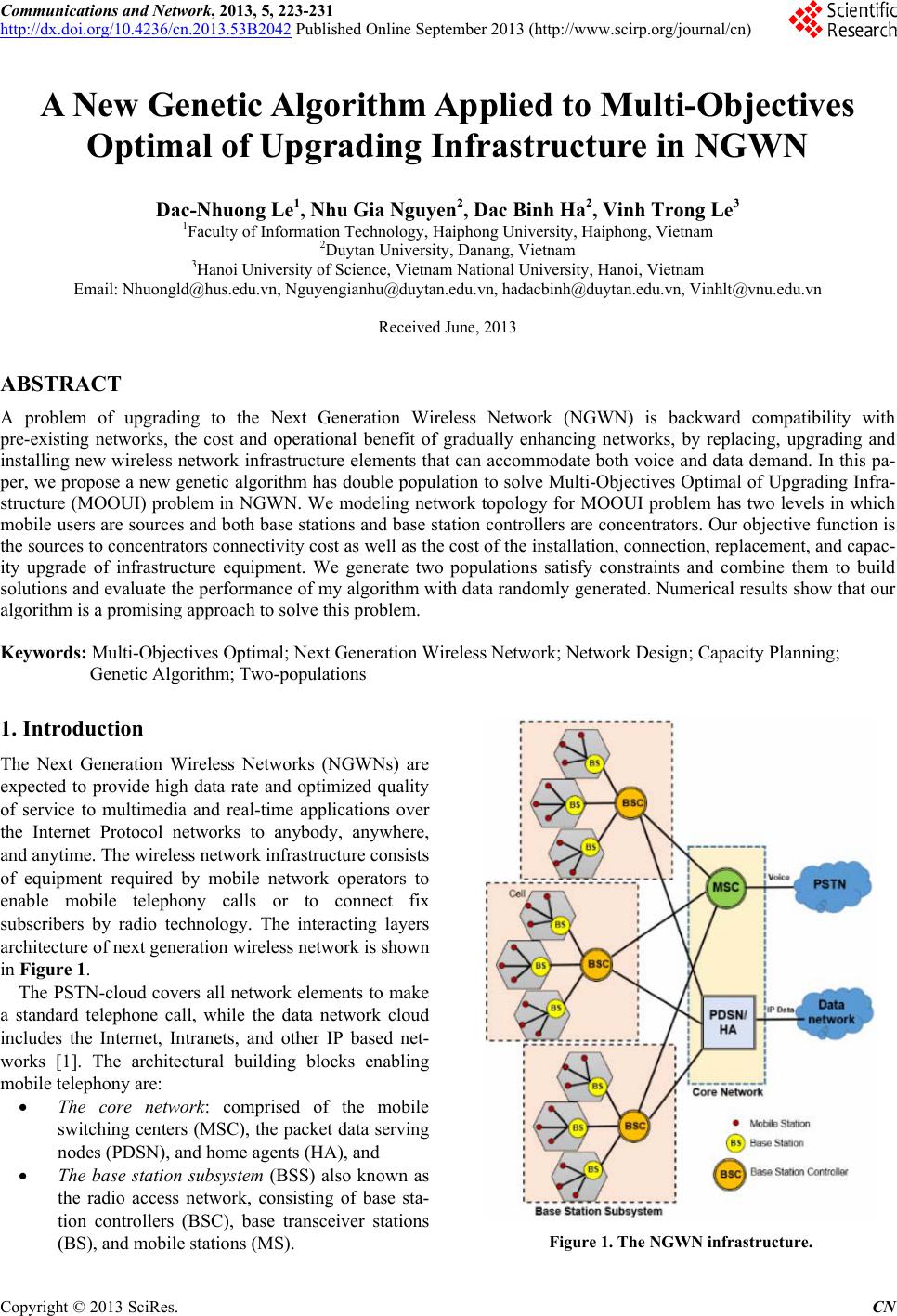 Communications and Network, 2013, 5, 223-231 http://dx.doi.org/10.4236/cn.2013.53B2042 Published Online September 2013 (http://www.scirp.org/journal/cn) A New Genetic Algorithm Applied to Multi-Objectives Optimal of Upgrading Infrastructure in NGWN Dac-Nhuong Le1, Nhu Gia Nguyen2, Dac Binh Ha2, Vinh Trong Le3 1Faculty of Information Technology, Haiphong University, Haiphong, Vietnam 2Duytan University, Danang, Vietnam 3Hanoi University of Science, Vietnam National Universi ty, Hanoi, Vietnam Email: Nhuongld@hus.edu.vn, Nguyengianhu@duytan.edu.vn, hadacbinh@duytan.edu.vn, Vinhlt@vnu.edu.vn Received June, 2013 ABSTRACT A problem of upgrading to the Next Generation Wireless Network (NGWN) is backward compatibility with pre-existing networks, the cost and operational benefit of gradually enhancing networks, by replacing, upgrading and installing new wireless network infrastructure elements that can accommodate both voice and data demand. In this pa- per, we propose a new genetic algorithm has double population to solve Multi-Objectives Op timal of Upgrading Infra- structure (MOOUI) problem in NGWN. We modeling network topology for MOOUI problem has two levels in which mobile users are sources and both base stations and base station controllers are concentrators. Our objective function is the sources to concentrators connectivity cost as well as the cost of the installation, connection, replacement, and capac- ity upgrade of infrastructure equipment. We generate two populations satisfy constraints and combine them to build solutions and evaluate th e performance of my algorithm with data randomly generated. Numerical results show that our algorithm is a promising approach to solve this problem. Keywords: Multi-Objectives Optimal; Next Generation Wireless Network; Network Design; Capacity Planning; Genetic Algorithm; Two-populations 1. Introduction The Next Generation Wireless Networks (NGWNs) are expected to provide high data rate and optimized quality of service to multimedia and real-time applications over the Internet Protocol networks to anybody, anywhere, and anytime. The wir eless netw ork infrastructure con sists of equipment required by mobile network operators to enable mobile telephony calls or to connect fix subscribers by radio technology. The interacting layers architecture of next generation wireless network is shown in Figure 1. The PSTN-cloud covers all network elements to make a standard telephone call, while the data network cloud includes the Internet, Intranets, and other IP based net- works [1]. The architectural building blocks enabling mobile telephony are: The core network: comprised of the mobile switching centers (MSC), the packet data serving nodes (PDSN), and home agents (HA), and The base station subsystem (BSS) also known as the radio access network, consisting of base sta- tion controllers (BSC), base transceiver stations (BS), and mobile stations (MS). Figure 1. The NGWN infrastructure. C opyright © 2013 SciRes. CN 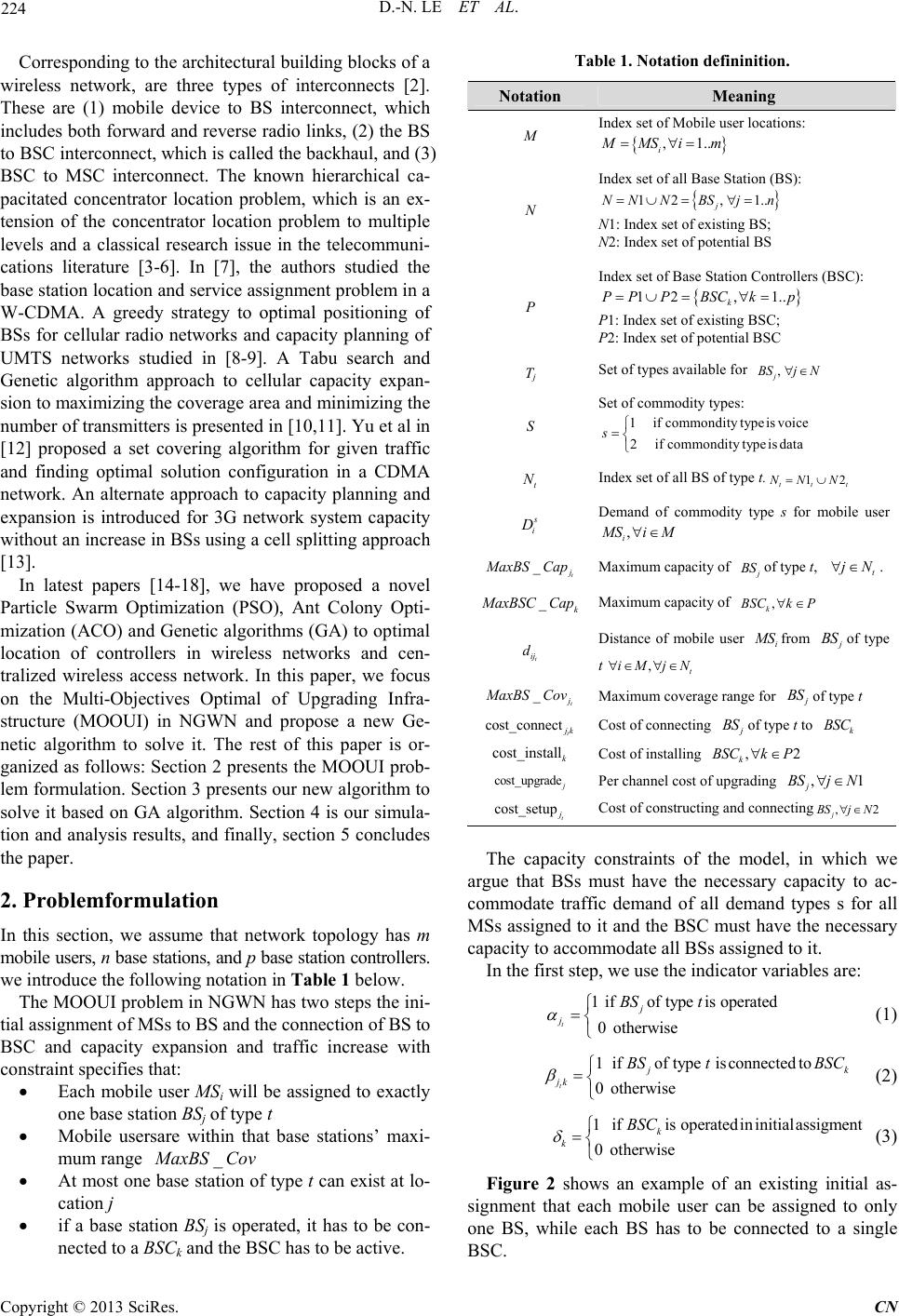 D.-N. LE ET AL. 224 Corresponding to the architectural building blocks of a wireless network, are three types of interconnects [2]. These are (1) mobile device to BS interconnect, which includes both forward and reverse radio links, (2) the BS to BSC interconnect, which is called the backhaul, and (3) BSC to MSC interconnect. The known hierarchical ca- pacitated concentrator location problem, which is an ex- tension of the concentrator location problem to multiple levels and a classical research issue in the telecommuni- cations literature [3-6]. In [7], the authors studied the base station location an d service assignment prob lem in a W-CDMA. A greedy strategy to optimal positioning of BSs for cellular radio networks and capacity planning of UMTS networks studied in [8-9]. A Tabu search and Genetic algorithm approach to cellular capacity expan- sion to maximizing the coverage area and minimizing the number of transmitters is presented in [10,11]. Yu et al in [12] proposed a set covering algorithm for given traffic and finding optimal solution configuration in a CDMA network. An alternate approach to capacity planning and expansion is introduced for 3G network system capacity without an increase in BSs using a cell splitting app roach [13]. In latest papers [14-18], we have proposed a novel Particle Swarm Optimization (PSO), Ant Colony Opti- mization (ACO) and Genetic algorithms (GA) to optimal location of controllers in wireless networks and cen- tralized wireless access network. In this paper, we focus on the Multi-Objectives Optimal of Upgrading Infra- structure (MOOUI) in NGWN and propose a new Ge- netic algorithm to solve it. The rest of this paper is or- ganized as follows: Section 2 presents the MOOUI prob- lem formulation. Section 3 presents our new algorithm to solve it based on GA algorithm. Section 4 is our simula- tion and analysis resu lts, and finally, section 5 concludes the paper. 2. Problemformulation In this section, we assume that network topology has m mobile users, n base stations, and p base station controllers. we introduce the following notation in Table 1 below. The MOOUI problem in NGWN has two steps the ini- tial assignment of MSs to BS and the connection of BS to BSC and capacity expansion and traffic increase with constraint specifies that: Each mobile user MSi will be assigned to exactly one base station BSj of type t Mobile usersare within that base stations’ maxi- mum ran ge _ axBSCov At most one base station of type t can exist at lo- cation j if a base station BSj is operated, it has to be con- nected to a BSCk and the BSC has to be active. Table 1. Notation defininition. Notation Meaning M Index set of Mobile user locations: ,1.. i MS im N Index set of all Base Station (BS): 12, 1.. j NN NBS jn N1: Index set of exi sting BS; N2: Index set of potential BS P Index set of Base Station Controllers (BSC): 12, 1.. k PP BSCkp P1: Index set of exis ting BSC; P2: Index set of potential BSC Tj Set of types available for , j SjN S Set of commodity types: 1if commonditytypeisvoice 2if commonditytypeisdata s t N Index set of all BS of type t. 12 tt t NN i Demand of commodity type s for mobile user , i SiM _t axBS CapMaximum capacity of BS of type t, t N . _k axBSC CapMaximum capacity of , k SCk P t ij d Distance of mobile user i Sfrom j Sof type t ,t iMjN _t axBS CovMaximum coverage range for j Sof type t cost_connect t kCost of connecting j Sof type t to k BSC cost_installk Cost of installing ,2 k BSCk P cost_upgradej Per channel cost of upgrading ,1 j SjN cost_setup t Cost of constructing and connecting,2 j BSj N The capacity constraints of the model, in which we argue that BSs must have the necessary capacity to ac- commodate traffic demand of all demand types s for all MSs assigned to it and the BSC must have the necessary capacity to accommodate all BSs assigned to it. In the first step, we use the indicator variables are: 1ifoftype isoperated 0otherwise t j j BS t (1) 1ifof typeisconnectedto 0otherwise t k jk BS tBSC (2) 1ifis operatedininitialassigment 0otherwise k k BSC (3) Figure 2 shows an example of an existing initial as- signment that each mobile user can be assigned to only one BS, while each BS has to be connected to a single BSC. Copyright © 2013 SciRes. CN 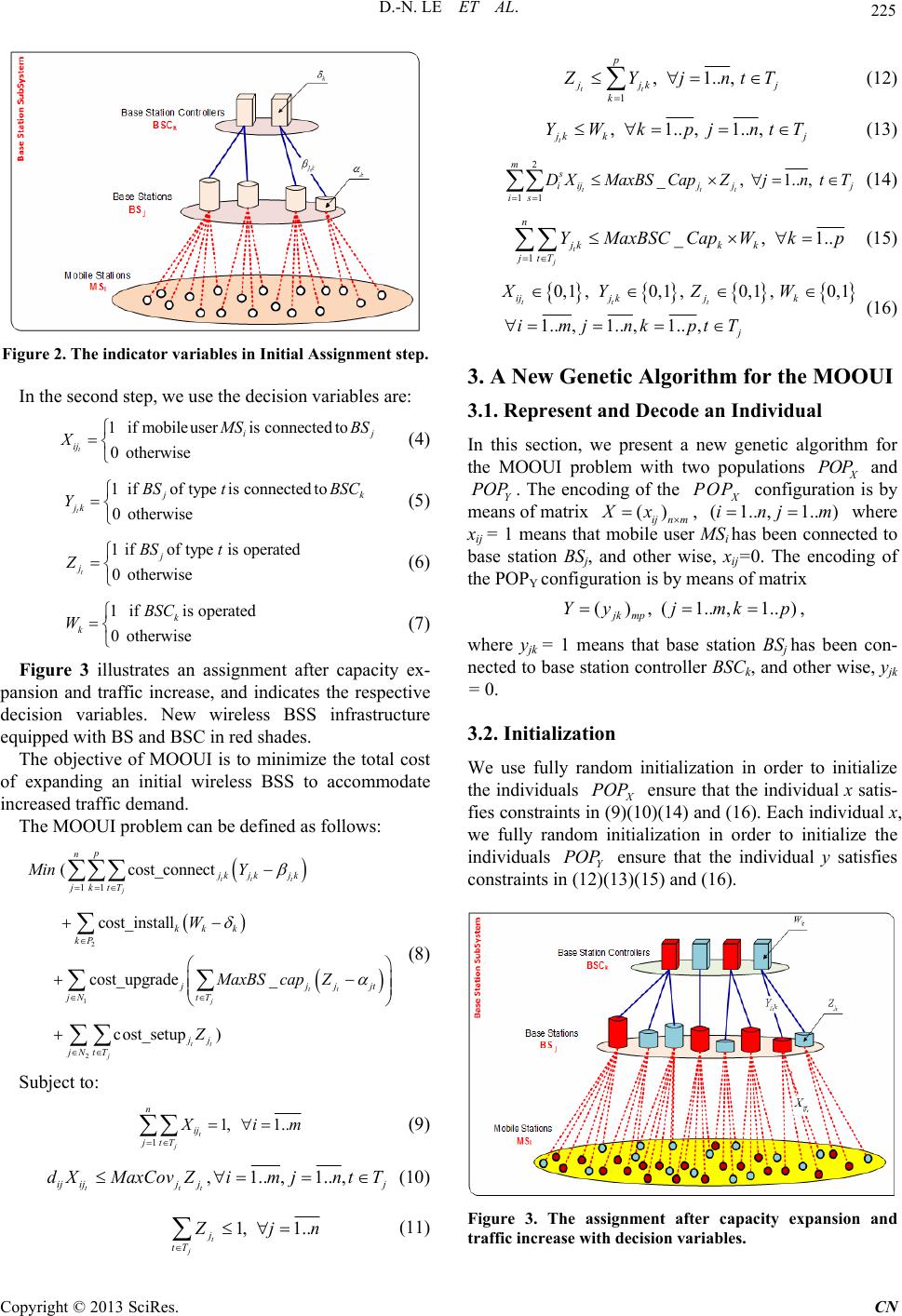 D.-N. LE ET AL. 225 Figure 2. The indicator variables in Initial Assignment step. In the second step, we use the decision variables are: 1if mobileuseris connectedto 0otherwise t i ij j SB X S (4) 1ifof typeis connectedto 0otherwise t k jk BS tBSC Y (5) 1ifof typeis operated 0otherwise t j j BS t Z (6) 1ifis operated 0otherwise k k BSC W (7) Figure 3 illustrates an assignment after capacity ex- pansion and traffic increase, and indicates the respective decision variables. New wireless BSS infrastructure equipped with BS and BSC in red shades. The objective of MOOUI is to minimize the total cost of expanding an initial wireless BSS to accommodate increased traffic demand. The MOOUI problem can be defined as follows: 2 1 2 11 ( cost_connect cost_install cost_upgrade _ cost_setup ) tt t j tt j tt j p n jk jkjk jktT kk k kP jjj jN tT jj jNtT Min Y W MaxBS capZ Z jt (8) Subject to: 1 1, 1.. t j n ij jtT im (9) ,1..,1.., ttt ij ijjjj dXMaxCovZimjnt T (10) 1, 1.. t j j tT j 1 ,1.., tt p jk j k Yjnt T (12) ,1..,1.. , t kk j YWkpj ntT (13) 2 11 _,1.., ttt ms iijj jj is XMaxBSCapZjntT (14) 1 ,1. t j n jkk k jtT YMaxBSC CapWkp . (15) 0,1 ,0,1 ,0,1 ,0,1 1..,1.. ,1.., tt t ijj kjk j XYZW imjnk ptT (16) 3. A New Genetic Algorithm for the MOOUI 3.1. Represent and Decode an Individual In this section, we present a new genetic algorithm for the MOOUI problem with two populations X and Y. The encoding of the configuration is by means of matrix POP POP X POP m () ij n Xx , where xij = 1 means that mobile user MSi has been connected to base station BSj, and other wise, xij=0. The encoding of the POPY configuration is by means of matrix (1..,1inj..)m (), (1..,1..) jk mp Yyjmkp , where yjk = 1 means that base station BSj has been con- nected to base station controller BSCk, and other wise, yjk = 0. 3.2. Initialization We use fully random initialization in order to initialize the individuals X ensure that the individual x satis- fies constraints in (9)(10)(14) and (16). Each individual x, we fully random initialization in order to initialize the individuals Y ensure that the individual y satisfies constraints in (12)(13)(15) and (16). POP POP Figure 3. The assignment after capacity expansion and traffic increase with decision variables. n (11) Copyright © 2013 SciRes. CN 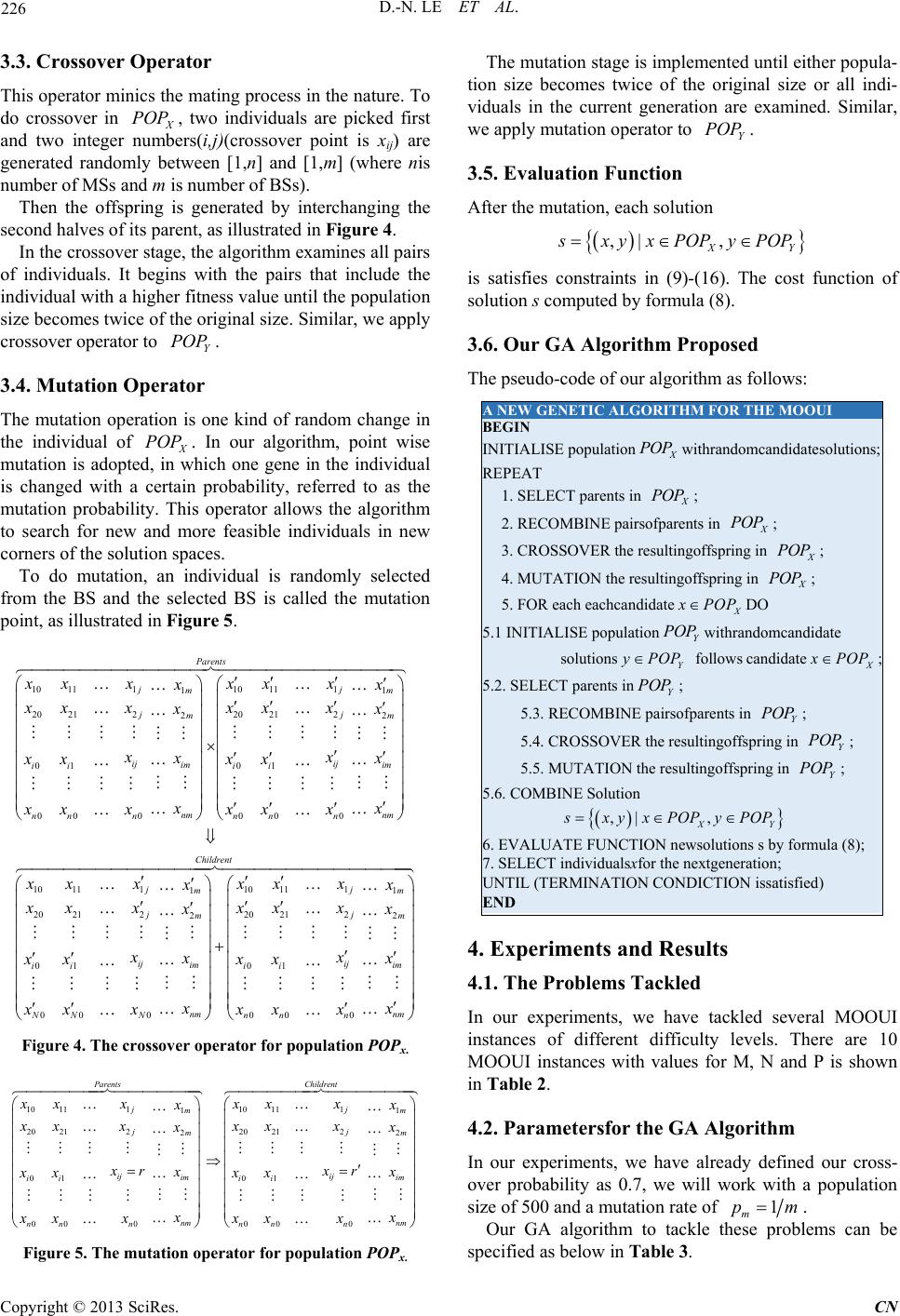 D.-N. LE ET AL. 226 3.3. Crossover Operator This operator minics the mating process in the nature. To do crossover in X, two individuals are picked first and two integer numbers(i,j)(crossover point is xij) are generated randomly between [1,n] and [1,m] (where nis number of MSs and m is number of BSs). POP Then the offspring is generated by interchanging the second halves of its parent, as illustrated in Figure 4. In the crossover stage, the algorithm examines all pairs of individuals. It begins with the pairs that include the individual with a higher fitn ess value until the p opulation size becomes twice of the original size. Similar, we apply crossover operator to . Y POP 3.4. Mutation Operator The mutation operation is one kind of random change in the individual of X. In our algorithm, point wise mutation is adopted, in which one gene in the individual is changed with a certain probability, referred to as the mutation probability. This operator allows the algorithm to search for new and more feasible individuals in new corners of the solution spaces. POP To do mutation, an individual is randomly selected from the BS and the selected BS is called the mutation point, as illustrated in Figure 5. 10 11110 111 1 20 21220 212 2 01 01 00 000 0 Parent j m j m ij ij im im ii ii nm nm nn nnn n xx xxx x x xx xxx x x xx xx xx xx xx xx xxx x 1011110 111 1 2021220212 22 01 01 000000 s j m jj mm ij ij im im ii ii nm nm NNNnnn xxxxxx 1 2 j m j m x x 1 j m x xxxxxx xx xx x xx xx x xxxxx x Childrent 2 j m x x x Figure 4. The crossover operator for population POPx. 10 11110 111 11 20 21220212 2 01 01 00 0000 Parents jj mm j m ij ij im im ii ii nm nm nn nnnn xx xxxx xx xx xxxx x xr xr x xx xx x xx xxxx Childrent Figure 5. The mutation operator for population POPx. The mutation stage is implemented until eith er popula- tion size becomes twice of the original size or all indi- viduals in the current generation are examined. Similar, we apply mutation operator to . Y POP 3.5. Evaluation Function After the mutation, each solution ,| , XY x yxPOPyPOP is satisfies constraints in (9)-(16). The cost function of solution s computed by formula (8). 3.6. Our GA Algorithm Proposed The pseudo-code of our algorithm as follows: A NEW GENETIC ALGORITHM FOR THE MOOUI BEGIN INITIALISE populationX OP withrandomcandidatesolutions; REPEAT 1. SELECT parents in X OP ; 2. RECOMBINE pairsofparents in X OP ; X OP 3. CROSSOVER the resultingoffspring in ; 4. MUTATION the resultingoffspring in X OP ; X POP 5. FOR each eachcandidateDO 5.1 INITIALISE populationY OP withrandomcandidate solutions Y yPOP follows candidateX POP ; 5.2. SE LECT parents inY OP ; Y OP 5.3. RECOMBINE pairsofparents in ; 5.4. CROSSOVER the resultingoffspring in Y OP ; Y OP 5.5. MUTATION the resultingoffspring in ; 5.6. COMBINE Solution ,| , XY x yxPOPyPOP 6. EVALUATE FUNCTION newsolutions s by formula (8); 7. SELECT individualsxfor the nextgeneration; UNTIL (TERMINATION CONDICTION issatisfied) END 4. Experiments and Results 4.1. The Problems Tackled In our experiments, we have tackled several MOOUI instances of different difficulty levels. There are 10 MOOUI instances with values for M, N and P is shown in Table 2. 4.2. Parametersfor the GA Algorithm In our experiments, we have already defined our cross- over probability as 0.7, we will work with a population size of 500 and a mutation ra te of 1 m pm. Our GA algorithm to tackle these problems can be specified as below in Table 3. Copyright © 2013 SciRes. CN 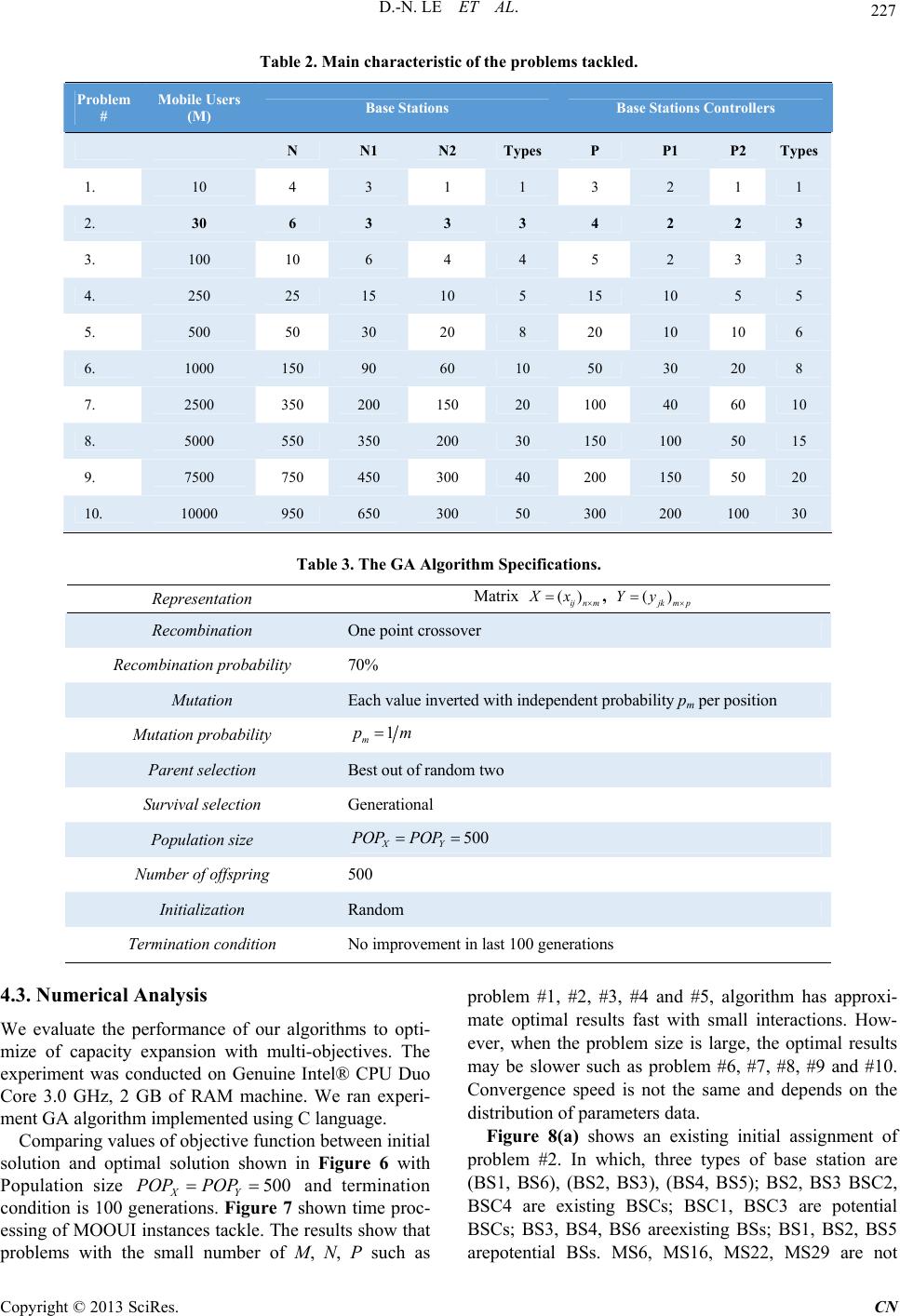 D.-N. LE ET AL. Copyright © 2013 SciRes. CN 227 Table 2. Main characteristic of the problems tackled. Problem # Mobile Users (M) Base Stat i ons Base Stat i ons Cont r ol ler s N N1 N2 Types P P1 P2 Types 1. 10 4 3 1 1 3 2 1 1 2. 30 6 3 3 3 4 2 2 3 3. 100 10 6 4 4 5 2 3 3 4. 250 25 15 10 5 15 10 5 5 5. 500 50 30 20 8 20 10 10 6 6. 1000 150 90 60 10 50 30 20 8 7. 2500 350 200 150 20 100 40 60 10 8. 5000 550 350 200 30 150 100 50 15 9. 7500 750 450 300 40 200 150 50 20 10. 10000 950 650 300 50 300 200 100 30 Table 3. The GA Algorithm Specifications. Representation Matrix () ijnm Xx , () jkmp Yy Recombination One point crossover Recombination probability 70% Mutation Each value inverted with independent probability pm per position Mutation probability 1 m pm Parent selection Best out of random two Survival selection Generational Population size 500 XY POP POP Number of offspring 500 Initialization Random Termination condition No improvement in last 100 generations 4.3. Numerical Analysis problem #1, #2, #3, #4 and #5, algorithm has approxi- mate optimal results fast with small interactions. How- ever, when the problem size is large, the optimal results may be slower such as problem #6, #7, #8, #9 and #10. Convergence speed is not the same and depends on the distribution of parameters data. We evaluate the performance of our algorithms to opti- mize of capacity expansion with multi-objectives. The experiment was conducted on Genuine Intel® CPU Duo Core 3.0 GHz, 2 GB of RAM machine. We ran experi- ment GA algorithm implemented using C language. Figure 8(a) shows an existing initial assignment of problem #2. In which, three types of base station are (BS1, BS6), (BS2, BS3), (BS4, BS5); BS2, BS3 BSC2, BSC4 are existing BSCs; BSC1, BSC3 are potential BSCs; BS3, BS4, BS6 areexisting BSs; BS1, BS2, BS5 arepotential BSs. MS6, MS16, MS22, MS29 are not Comparing values of objective function between initial solution and optimal solution shown in Figure 6 with Population size and termination condition is 100 generations. Figure 7 shown time proc- essing of MOOUI instances tackle. The results show that problems with the small number of M, N, P such as 500 XY POP POP 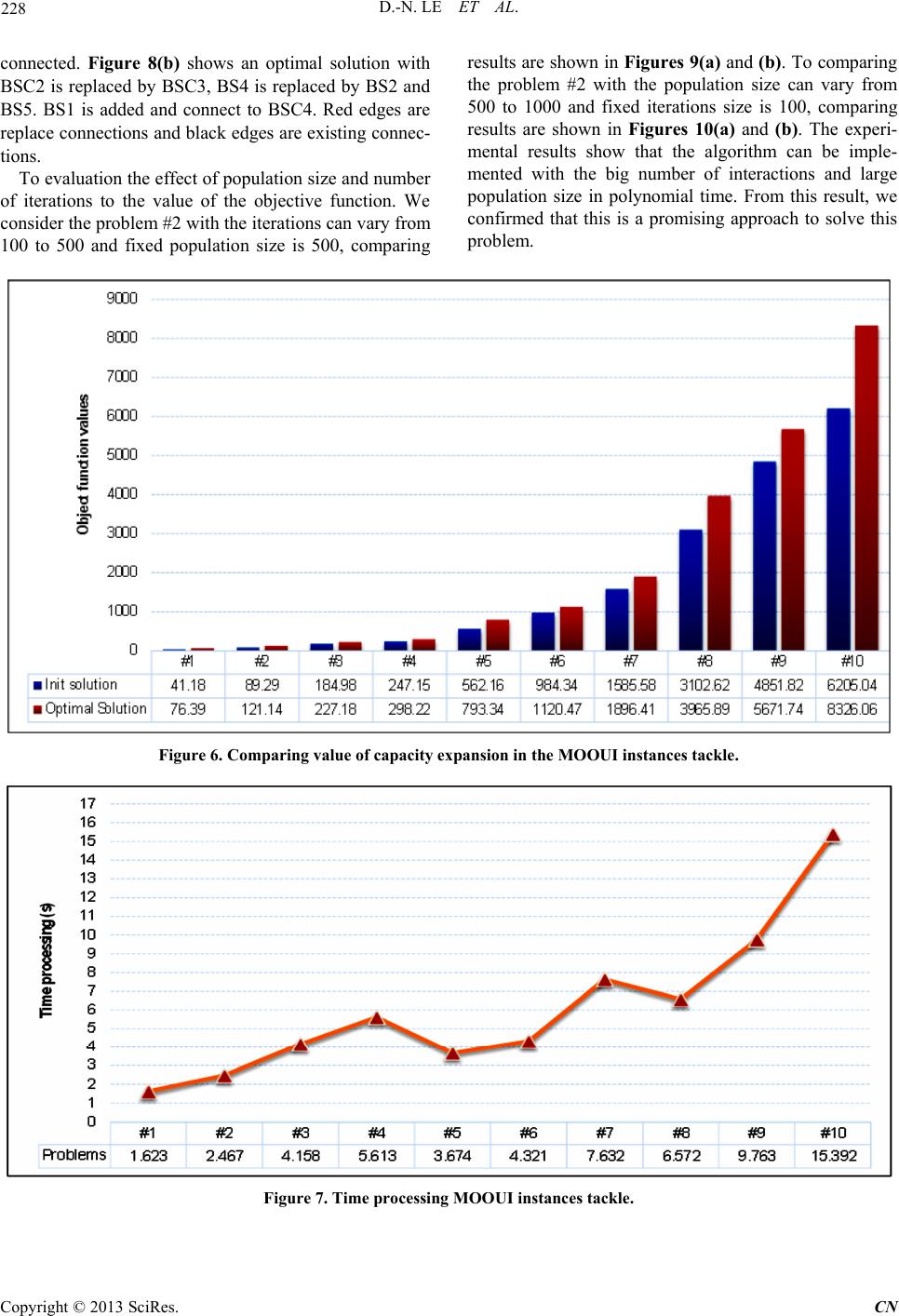 D.-N. LE ET AL. 228 connected. Figure 8(b) shows an optimal solution with BSC2 is replaced by BSC3, BS4 is replaced by BS2 and BS5. BS1 is added and connect to BSC4. Red edges are replace connections and black edges are existing connec- tions. To evaluation the effect of population size and number of iterations to the value of the objective function. We consider the problem #2 with the iterations can vary from 100 to 500 and fixed population size is 500, comparing results are shown in Figures 9(a) and (b). To comparing the problem #2 with the population size can vary from 500 to 1000 and fixed iterations size is 100, comparing results are shown in Figures 10(a) and (b). The experi- mental results show that the algorithm can be imple- mented with the big number of interactions and large population size in polynomial time. From this result, we confirmed that this is a promising approach to solve this problem. Figure 6. Comparing value of capacity expansion in the MOOUI instances tackle. Figure 7. Time processing MOOUI instances tackle. Copyright © 2013 SciRes. CN 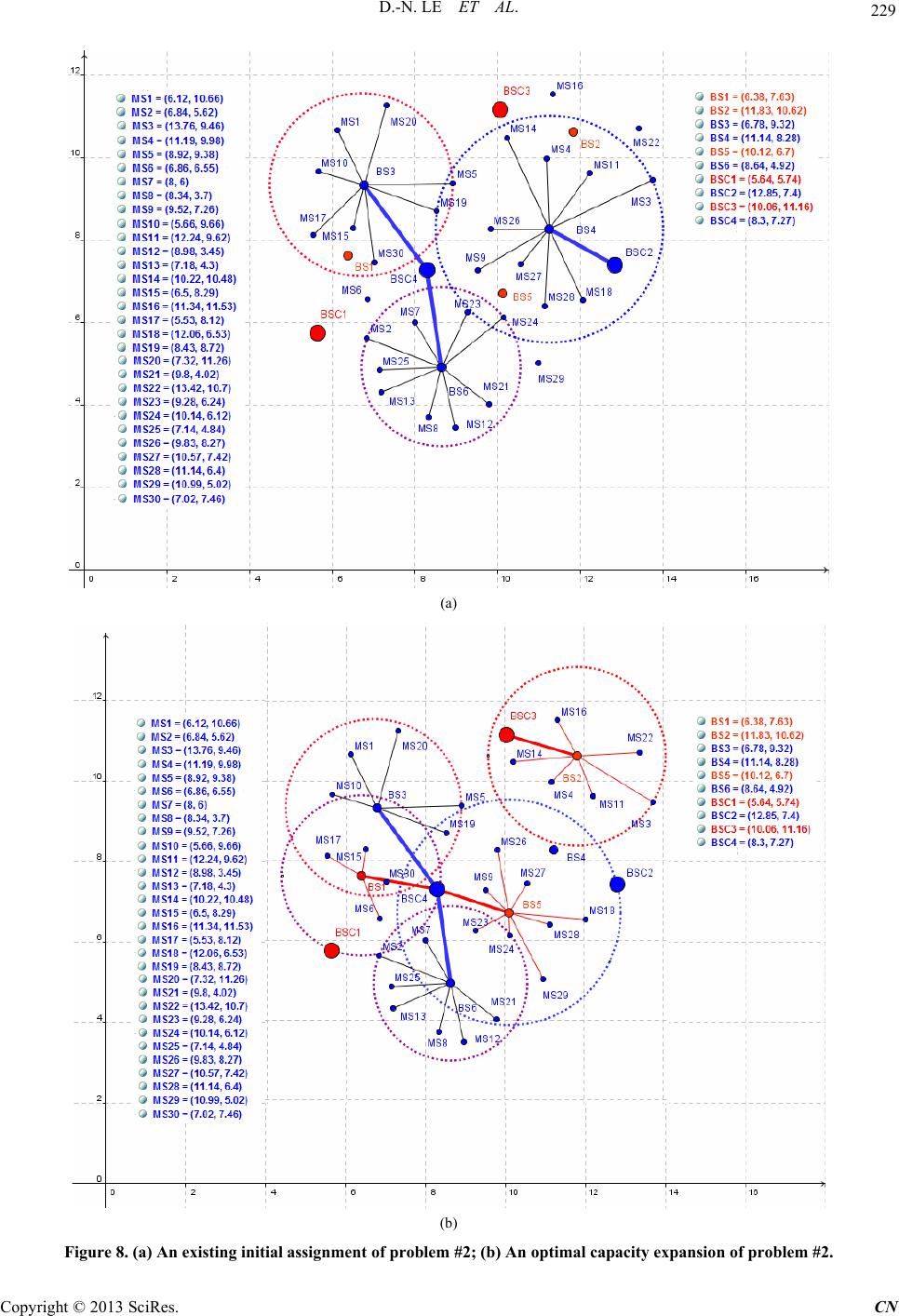 D.-N. LE ET AL. 229 (a) (b) Figure 8. (a) An existing initial assignment of problem #2; (b) An optimal capacity expansion of problem #2. Copyright © 2013 SciRes. CN 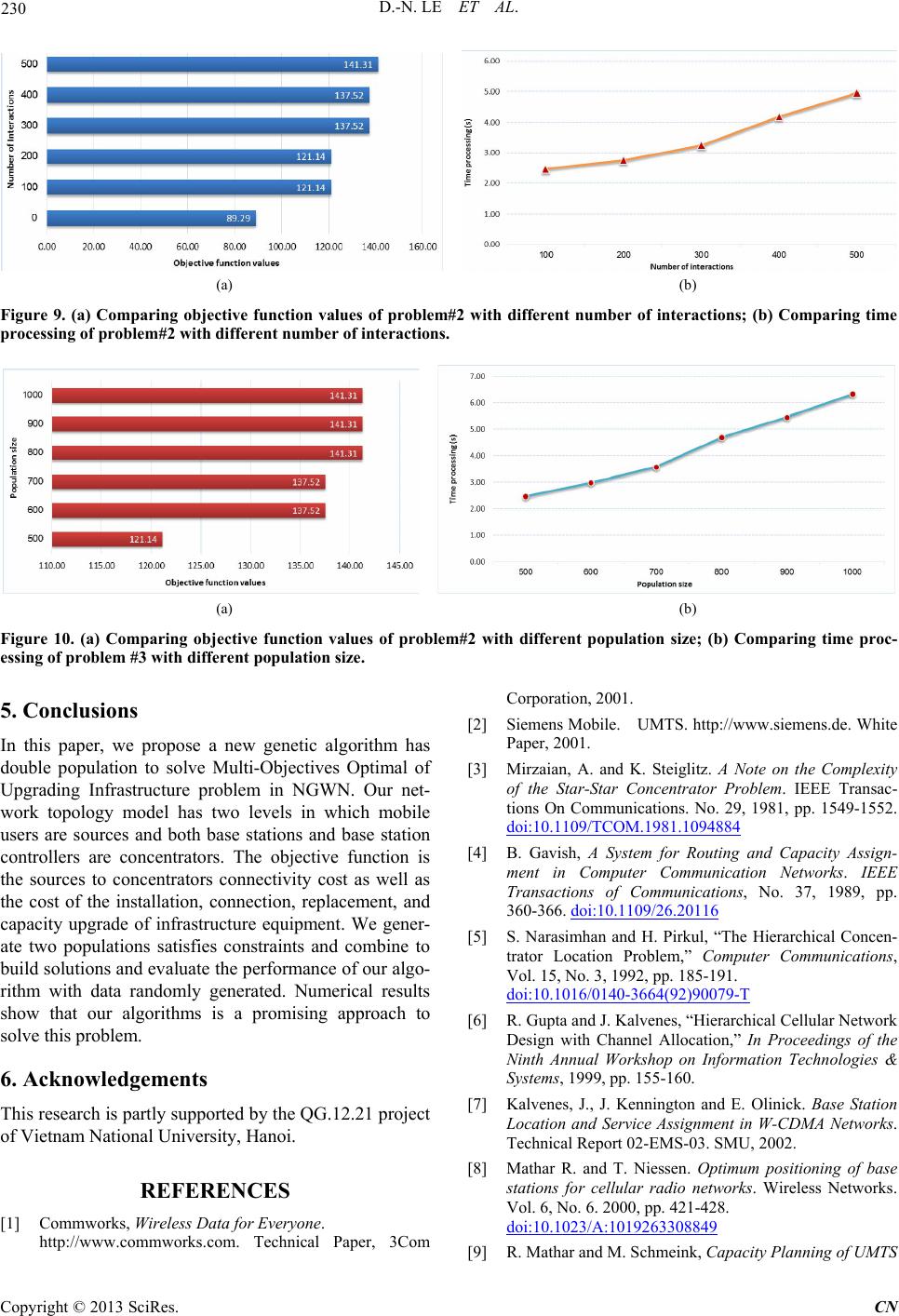 D.-N. LE ET AL. Copyright © 2013 SciRes. CN 230 (a) (b) Figure 9. (a) Comparing objective function values of problem#2 with different number of interactions; (b) Comparing time processing of problem#2 with different number of interactions. (a) (b) Figure 10. (a) Comparing objective function values of problem#2 with different population size; (b) Comparing time proc- essing of problem #3 with different population size. 5. Conclusions In this paper, we propose a new genetic algorithm has double population to solve Multi-Objectives Optimal of Upgrading Infrastructure problem in NGWN. Our net- work topology model has two levels in which mobile users are sources and both base stations and base station controllers are concentrators. The objective function is the sources to concentrators connectivity cost as well as the cost of the installation, connection, replacement, and capacity upgrade of infrastructure equipment. We gener- ate two populations satisfies constraints and combine to build solutions and evaluate the performance of our algo- rithm with data randomly generated. Numerical results show that our algorithms is a promising approach to solve this problem. 6. Acknowledgements This research is partly supported by the QG.12.21 project of Vietnam National University, Hanoi. REFERENCES [1] Commworks, Wireless Data for Everyone. http://www.commworks.com. Technical Paper, 3Com Corporation, 2001. [2] Siemens Mobile. UMTS. http://www. siemens.de. White Paper, 2001. [3] Mirzaian, A. and K. Steiglitz. A Note on the Complexity of the Star-Star Concentrator Problem. IEEE Transac- tions On Communications. No. 29, 1981, pp. 1549-1552. doi:10.1109/TCOM.1981.1094884 [4] B. Gavish, A System for Routing and Capacity Assign- ment in Computer Communication Networks. IEEE Transactions of Communications, No. 37, 1989, pp. 360-366. doi:10.1109/26.20116 [5] S. Narasimhan and H. Pirkul, “The Hierarchical Concen- trator Location Problem,” Computer Communications, Vol. 15, No. 3, 1992, pp. 185-191. doi:10.1016/0140-3664(92)90079-T [6] R. Gupta and J. Kalvenes, “Hierarchical Cellular Network Design with Channel Allocation,” In Proceedings of the Ninth Annual Workshop on Information Technologies & Systems, 1999, pp. 155-160. [7] Kalvenes, J., J. Kennington and E. Olinick. Base Station Location and Service Assignment in W-CDMA Networks. Technical Report 02-EMS-03. SMU, 2002. [8] Mathar R. and T. Niessen. Optimum positioning of base stations for cellular radio networks. Wireless Networks. Vol. 6, No. 6. 2000, pp. 421-428. doi:10.1023/A:1019263308849 [9] R. Mathar and M. Schmeink, Capacity Planning of UMTS  D.-N. LE ET AL. 231 Networks. In Proceedings of Sixth INFORMS Telecom- munications Conference, Boca Raton, Florida 2002. [10] C. Y. Lee and H. Kang, “Cell Planning with Capacity Expansion in Mobile Communications: A Tabu Search Approach,” IEEE Transactions on Vehicular Technology, Vol. 49, No. 5. 2000, pp. 1678-1691. doi:10.1109/25.892573/ [11] P. Calegari, F. Guidee, P. Kuonen and D. Wagner, “Ge- netic Approach to Radio Network Optimization for Mo- bile Systems,” IEEE VTC, pp. 755-759, 1997. [12] C. Yu, S. Subramanian and N. Jain, “CDMA cell site optimization using a set covering algorithm,” In Pro- ceedings of Eight Int. Network Planning Symposium, 1998, pp. 75-78. [13] R. Giuliano, F. Mazzenga and F. Vatalaro, “Smart cell sectorization for third generation CDMA systems,” Wire- less Communications and Mobile Computing, Vol. 2, No. 3, 2002, pp. 253-267. [14] Dac-Nhuong Le, “Genetic Algorithm Applied to the Op- timal Centralized Wireless Access Network,” Interna- tional Journal of Information & Network Security (IJINS), Vol. 2, No. 2, 2013, pp. 129-137. [15] Dac-Nhuong Le and Nhu Gia Nguyen, “A New Evolu- tionary Approach for Gateway Placement in Wireless Mesh Networks,” International Journal of Computer Networks and Wireless Communications (IJCNWC), Vol. 2, No. 5, 2012, pp. 550-555. [16] Dac-Nhuong Le, “PSO and ACO Algorithms Applied to optimal Resource Allocation to Support QoS Require- ments in Next Generation Networks,” International Jour- nal of Information & Network Security (IJINS), Vol. 2, No. 3, 2013, pp. 216-228. [17] Dac-Nhuong Le, “PSO and ACO Algorithms Applied to Optimizing Location of Controllers in Wireless Net- works,” International Journal of Computer Science and Telecommunications (IJCST), Vol. 3, No. 10, 2012, pp. 1-7. [18] Dac-Nhuong Le, “Optimizing the cMTS to Improve Quality of Service in Next Generation Networks based on ACO Algorithm,” International Journal of Computer Network and Information Security (IJCNIS), Vol. 5, No. 4, 2013, pp. 25-30. doi:10.5815/ijcnis.2013.04.04 [19] Dac-Nhuong Le, “EA and ACO Algorithms Applied to Optimizing Location of Controllers in Wireless Net- works,” International Journal of Network Communica- tion and Networking (IJNCN), Vol. 3, No. 2, 2013, pp. 17-27. [20] Dac-Nhuong Le, Nhu Gia Nguyen and Vinh Trong Le, “A Novel Ant Colony Optimization-based Algorithm for the Optimal Centralized Wireless Access Network,” Lec- ture Notes of the Institute for Computer Sciences, Social Informatics and Telecommunications Engineering (LNICST), Springer 2013. Copyright © 2013 SciRes. CN
|